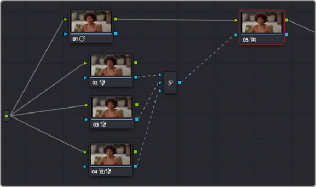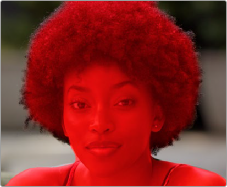

< Previous | Contents | Next >
At this point, you can try doing different color adjustments using two different correction nodes, one for the subject’s hair, and another using Magic Mask to isolate everything but the hair.
Alternately, if you want a single matte with which to isolate the entire subject, you can then use additional instances of the Magic Matte tool (one per node), using one node to isolate just the face and body without the hair, and a third node to isolate the entire subject but with a very soft edge. Then, you can use a Key Mixer node to combine all these masks together with the original hair mask you created, with which to feed a complete key to another node used to make the correction.


(Left) Nodes 2, 3, and 4 are creating three different masks that are combined using a key mixer and connected to the Key input of Node 5 to make an adjustment, (Right) The final result of this three-mask approach.
While hair with soft edges can be a challenge, Magic Mask excels at many elaborate hair styles with detailed shapes and hair accessories, including jewelry and ribbons. For example, the stylized
hairstyles found in European and Chinese period movies and shows give the DaVinci Neural Engine no trouble at all, particularly as these styles are usually tightly bound with no wispy hair.
Asymmetrical hairstyles may require extra strokes to identify hair that’s significantly longer on one side of the face. This may also be true for unorthodox hair styles, such as hair that’s been sculpted into distinct sculptural shapes. Lastly, tight braids that expose skin on the scalp are also challenging for the kind of hard masks that Magic Mask produces, so you’re better off using Magic Mask as a garbage matte and using a keyer to create a detailed soft mask to use in these instances.
About Hats
![]()
Magic Mask works with an incredibly wide variety of hats from all time periods. On hats, tassels or details like feathers can be a problem (in testing, the feather on Errol Flynn’s cap in Robin Hood couldn’t consistently be included, even though the cap itself was no problem). Additionally, veils that are part of hats may or may not be easily identified, but an additional stroke usually solves the problem.
Dealing With Accessories
Things that people are holding, such as handkerchiefs or umbrellas, are best selected in Object mode. Jewelry and watches pose a special problem, as they’re typically so thin and small that they can be difficult to omit, but you may not want to include them depending on the adjustment you’re trying
to make. Your results will vary with the thickness of the items and the framing of your subject, but in general your results will probably be better if you simply add a stroke or two to include these items in the isolation, since omitting fine detail like a necklace can be problematic.